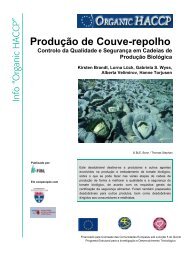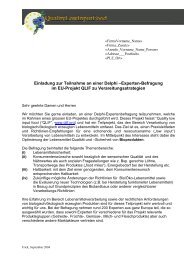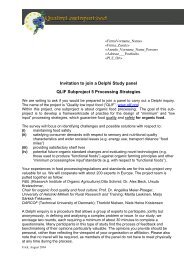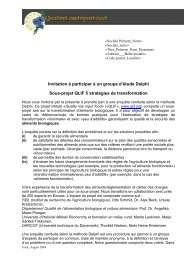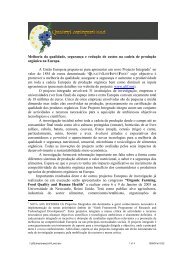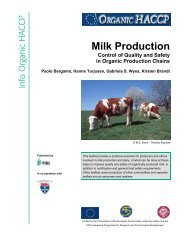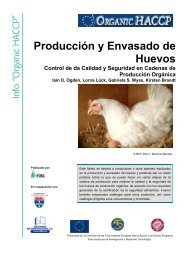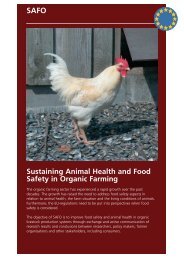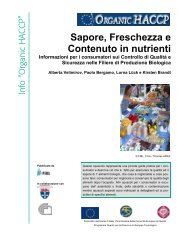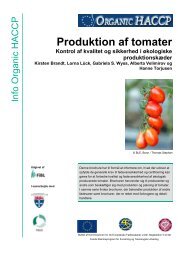Grape Production And Wine Processing
Grape Production And Wine Processing
Grape Production And Wine Processing
Create successful ePaper yourself
Turn your PDF publications into a flip-book with our unique Google optimized e-Paper software.
Info Organic HACCP<br />
<strong>Grape</strong> production<br />
and <strong>Wine</strong> <strong>Processing</strong><br />
Control of Quality and Safety<br />
in Organic <strong>Production</strong> Chains<br />
Gabriela S. Wyss and Bo van Elzakker<br />
© FiBL, Frick / Jacques Fuchs<br />
Published by<br />
In co-operation with<br />
This leaflet provides a practical overview for producers and others<br />
involved in grape production and wine processing, of what can be<br />
done at these steps to improve the quality and safety of organically<br />
produced wine, in addition to certification and general food safety<br />
requirements. Other leaflets cover production of other commodities<br />
and separate leaflets aim at consumers and retailers.<br />
Funded by the Commission of the European Communities under Key Action 5 of the<br />
Fifth Framework Programme for Research and Technological Development
The Organic HACCP Project leaflets<br />
This is no.14 of a series of 14 leaflets comprising information<br />
on how control of quality and safety can be further improved<br />
in organic supply chains across Europe. The Organic<br />
HACCP project has reviewed studies of consumer<br />
concerns and preferences in relation to organic production<br />
systems and collected information about typical production<br />
chains for 7 commodities in regions across Europe. For<br />
each of the criteria listed below, the information was analysed<br />
to identify Critical Control Points (CCPs), defined as<br />
the steps in supply chains where the qualities of the final<br />
product can be controlled most efficiently. CCPs were identified<br />
using methods developed for Hazard Analysis by Critical<br />
Control Points (HACCP), a standard procedure to prevent<br />
food safety risks. The new aspect is thus to improve<br />
how consumer concerns are addressed, through the use of<br />
the CCP concept for a wide range of criteria, not only safety.<br />
1. Microbial toxins and abiotic contaminants<br />
2. Potential pathogens<br />
3. Natural plant toxicants<br />
4. Freshness and taste<br />
5. Nutrient content and food additives<br />
6. Fraud<br />
7. Social and ethical aspects<br />
Overview of the chains examined for wine making<br />
Chain R2<br />
(Italy)<br />
<strong>Production</strong> of<br />
grapes by single<br />
producer<br />
<strong>Wine</strong> making by<br />
producer<br />
Transport of wine<br />
by transport<br />
Bottling by wine<br />
processor<br />
Transport of<br />
bottled wine by<br />
mail order<br />
Retail by mail<br />
order company<br />
Chain R3<br />
(Portugal)<br />
<strong>Production</strong> of<br />
grapes by single<br />
producer<br />
<strong>Wine</strong> making by<br />
producer<br />
Bottling by wine<br />
producer<br />
Transport of<br />
bottled wine by<br />
health food store<br />
Retail by health<br />
food store<br />
Chain R4<br />
(Switzerland)<br />
<strong>Production</strong> of<br />
grapes by single<br />
producer<br />
Transport of<br />
grapes by<br />
producer<br />
<strong>Wine</strong> making by<br />
wine processor<br />
Bottling by wine<br />
processor<br />
Transport of<br />
bottled wine by<br />
producer<br />
Retail by<br />
producer<br />
Chain R5<br />
(Switzerland)<br />
<strong>Production</strong> of<br />
grapes by single<br />
producer<br />
Transport of<br />
grapes by<br />
producer<br />
<strong>Wine</strong> making by<br />
wine processor<br />
Botteling by wine<br />
processor<br />
Transport of<br />
bottled wine by<br />
producer<br />
Retail by<br />
producer<br />
Chain R6<br />
(Switzerland)<br />
<strong>Production</strong> of<br />
grapes by single<br />
producer<br />
<strong>Wine</strong> making by<br />
producer<br />
Botteling by<br />
producer<br />
Retail by<br />
producer<br />
The diagram shows the analysed organic supply chains for<br />
wine throughout Europe. On the project’s homepage<br />
(www.organichaccp.org) they are shown in more detail and<br />
each of the CCPs are shown and described.<br />
<strong>Grape</strong> production<br />
Important issues to control at this step<br />
The typical wine taste is mainly determined by the cultivar.<br />
Secondary metabolites are the source of wine flavour, colour<br />
and taste. Their content is dependent on the cultivar, the<br />
microclimate and the nutrient supply of the grape vine.<br />
<strong>Grape</strong>vines have a low nitrogen requirement. Over-use of<br />
N-containing organic fertiliser can have negative influence<br />
on taste-relevant components in the wine.<br />
Specific problems for organic production<br />
Spray drift in regions with small-scale grape production by<br />
less careful conventional farmers or by helicopter applications<br />
(data from FiBL studies; see chart below) may result in<br />
contaminated grapes. It is the organic farmer who needs to<br />
take action to prevent any contamination of its products.<br />
Conventional<br />
Organic Rows<br />
Spray Drift [%]<br />
100<br />
by helicopter<br />
by regular spraying<br />
50<br />
25 25<br />
5 5<br />
1 1<br />
The fungal disease downy mildew, Plasmopora viticola, has<br />
traditionally been controlled by the use of copper salts, also<br />
in organic farming. The use of copper-based pesticides is a<br />
problem for the image of organic farming among consumers,<br />
and many retailers demand copper-free production. It<br />
has been banned from both conventional and organic farming<br />
in some Scandinavian countries and the Netherlands.<br />
Recommendations<br />
Select cultivars with good taste and low susceptibility to<br />
downy mildew and other diseases and pests. Make sure<br />
they have been tested and performed well in your region.<br />
Limit the use of N containing fertiliser and harvest late<br />
after sunny, warm days to optimise wine taste.<br />
If pesticides can have drifted onto your vineyard, get a<br />
leaf sample analyzed. If residues are found, either i) ask<br />
your conventional neighbour to buy the affected grapes<br />
from you for the same price as organic and cost of the<br />
analysis, or ii) harvest the first two rows separately, with<br />
subsequent separate processing and marketing.<br />
Agree with neighbours and helicopter operations on<br />
safety measures such as spraying only under certain wind<br />
conditions with well-maintained equipment, using substances<br />
allowed in organic farming on part of the conventional<br />
vineyard, restricting where the nozzles are open.<br />
Establish hedges or other barriers to protect the crop from<br />
spray drift from neighbours, and promote merging of small<br />
areas with organic vineyards including exchange of land.<br />
Use less than the permitted amount of copper (or none)<br />
and prepare for copper-free production in the future. Develop<br />
replacement strategies including the use of clay<br />
minerals, plant tonic and resistant cultivars.<br />
2
<strong>Wine</strong> processing<br />
Specific problems for organic production<br />
In cellars with parallel processing of organic and non-<br />
with<br />
organic grapes, there is a high risk for contamination<br />
pesticides up to levels which are not in compliance with the<br />
consumers’ idea of organic wine: Either mixing up of organic<br />
and non-organic grapes or juice, or carry-over of residues<br />
from insufficient cleaned hoses, filter layers, containers as<br />
well as the press, the bottling machine and handling of small<br />
volume containers.<br />
Recommendations (parallel wine processing operations)<br />
Evaluate each step along the processing line to locate<br />
those steps where pesticide residues can be introduced.<br />
As far as possible use dedicated organic equipment,<br />
hoses, containers, filters etc. (paint in different colours).<br />
Even if not required by the certifier, always process or-<br />
ganic material before non-organic, and thoroughly clean<br />
the entire system before starting up again with organic.<br />
Especially the filter layers may accumulate pesticides.<br />
Maintain permanent identification of each batch.<br />
Monitor and document both organic and non-organic<br />
activities (input-output reconciliation).<br />
<strong>Wine</strong> storage<br />
Important issues to control at this step<br />
As a grape producer stay in close contact with your wine<br />
maker, and discuss the problems which may rise with<br />
parallel processing in the wine cellar. Also exchange information<br />
about your quality control and their quality<br />
measurements with the companies and persons in charge<br />
of the other parts of the chain. Formal collaboration<br />
agreements can ensure that quality and safety is controlled<br />
at every step of the supply chain, and that the<br />
costs of this are shared fairly among the participants.<br />
Establish and maintain your own quality assurance system<br />
to prevent contamination or mislabelling: For each<br />
step, describe how it should be done on a checklist. Imag-<br />
ine what can go wrong and decide in advance what to do<br />
in each case of theoretical problems and accidents that<br />
may occur. Fill in these checklists for each batch, with<br />
date and time for each procedure and with notes describ-<br />
ing anything unusual that happened.<br />
Provide permanent identification of batches. Take retain<br />
samples of wine from all batches and let them analyse if<br />
you are in doubt.<br />
Continuation in other EU or national projects<br />
The work of Organic HACCP identified several areas where<br />
more research is needed to improve the control of quality<br />
and safety of organic products.<br />
The following topics relevant for quality and safety of grape<br />
production and wine making will be investigated in further<br />
EU or national projects:<br />
Replacement of Copper Fungicides in Organic <strong>Production</strong><br />
of <strong>Grape</strong>vine and Apple in Europe (REPCO), 6th Framework<br />
Programme, Contract no. 501452, Running from<br />
11/2003, 36 Months. Webpage: http://www.rep-co.nl/.<br />
Within the “Bundesprogramm Ökologischer Landbau”<br />
several projects deal either with replacement strategies<br />
for copper or general copper reduction, with the (biological)<br />
control of important fungal diseases of vine (Peronospora<br />
spp. and Oidium spp.) or preventive plant protection<br />
strategies; see http://www.bundesprogrammoekolandbau.de/projektliste.html,<br />
keywords: Pflanze,<br />
Wein (in German).<br />
Recommendations<br />
Parallel storage of un-bottled organic wine with non-organic<br />
and/or in conversion material increases the risk for uninten-<br />
tional or intentional blending to improve quality or increase<br />
financial gain. Consumers are concerned about the risk of<br />
fraud, especially when organic wine is much more expensive<br />
than wine produced conventionally.<br />
Store the wine in dedicated organic tanks/cellars.<br />
Maintain permanent identification of each batch on the<br />
tanks and casks.<br />
Monitor and document both organic and non-organic<br />
activities (input-output reconciliation).<br />
When bottling, make sure the label contains the name<br />
and address of the producer and the batch number.<br />
General Recommendations<br />
3
Editorial Notes<br />
The editors and authors gratefully acknowledge financial<br />
support from the Commission of the European Communities<br />
under Key Action 5 of the Fifth Framework Research and<br />
Technological Development Programme and co-funding by<br />
the Swiss Science Agency (SBF) for the project "Recommendations<br />
for improved procedures for securing consumer<br />
oriented food safety and quality of certified organic products<br />
from plough to plate" (Organic HACCP; QLK1-CT-2002-<br />
02245). The views expressed are those of the authors and<br />
do not necessarily reflect the views of the European Commission,<br />
nor do they in any way anticipate the Commission's<br />
future policy in this area.<br />
The content of the leaflet is the sole responsibility of the<br />
authors. The information contained herein, including any<br />
expression of opinion and any projection or forecast, has<br />
been obtained from sources believed by the authors to be<br />
reliable but is not guaranteed as to accuracy or completeness.<br />
The information is supplied without obligation and on<br />
the understanding that any person who acts upon it or otherwise<br />
changes his/her position in reliance thereon does so<br />
entirely at his/her own risk.<br />
Bibliographical Information<br />
Gabriela S. Wyss, Bo van Elzakker (2005): <strong>Grape</strong> <strong>Production</strong><br />
and <strong>Wine</strong> <strong>Processing</strong>, Control of Quality and Safety in<br />
Organic <strong>Production</strong> Chains. Research Institute of Organic<br />
Agriculture FiBL, CH-5070 Frick, Switzerland<br />
© 2005, Research Institute of Organic Agriculture FiBL and<br />
University of Newcastle Upon Tyne<br />
FiBL, Ackerstrasse, CH-5070 Frick, Tel. +41 62 865 72<br />
72, Fax +41 62 8657 273, e-mail info.suisse@fibl.org,<br />
Internet http://www.fibl.org<br />
University of Newcastle, Agriculture Building, UK – NE1<br />
7RU, Newcastle upon Tyne, e-mail<br />
organic.haccp@ncl.ac.uk, Internet<br />
http://www.ncl.ac.uk/afrd/tcoa/<br />
Language editing: Kirsten Brandt<br />
Cover & layout: FiBL<br />
Logo Organic HACCP: Tina Hansen, DIAS, Denmark<br />
A PDF version can be downloaded free of charge from the<br />
project internet site at www.organichaccp.org or from<br />
www.orgprints.org/view/projects/eu-organic-haccp.html.<br />
Printed versions can be ordered from the FiBL Shop at<br />
www.shop.fibl.org.<br />
Authors<br />
Gabriela S. Wyss (FiBL) and Bo van Elzakker (Agro Eco).<br />
Contact:<br />
Dr. Gabriela S. Wyss FiBL: Ackerstrasse, Postfach, 5070<br />
Frick, Switzerland.<br />
Tel. +41 62 865 72 72<br />
Fax +41 62 685 72 73<br />
e-mail: gabriela.wyss@fibl.org<br />
http://www.fibl.net/fibl/team/wyss-gabriela.php<br />
About Organic HACCP<br />
The main objectives of this Concerted Action are to assess<br />
current procedures for production management and control<br />
in organic production chains, with particular reference to the<br />
characteristics valued by consumers, and from this to formulate<br />
and disseminate recommendations for improvements.<br />
The 2-year project started in February 2003. The results of<br />
the project, including a database of Critical Control Points in<br />
the analysed chains, are available on the project website<br />
www.organichaccp.org.<br />
The Project Partners<br />
University of Newcastle (UNEW), Newcastle upon Tyne,<br />
United Kingdom.<br />
Research Institute of Organic Agriculture (FiBL), Frick,<br />
Switzerland.<br />
Royal Veterinary and Agricultural University (KVL), Copenhagen,<br />
Denmark.<br />
Italian National Research Council, Institute of Food Science<br />
(CNR-ISA), Avellino, Italy.<br />
University of Aberdeen (UNIABDN), Aberdeen, United<br />
Kingdom.<br />
Ludwig Boltzmann Institute for Biological Agriculture (LBI)<br />
Vienna, Austria.<br />
Universidade de Trás-os-Montes e Alto Douro (UTAD),<br />
Vila Real, Portugal.<br />
Agro EcoConsultancy BV (Agro Eco), Bennekom, The<br />
Netherlands.<br />
National Institute for Consumer Research (SIFO), Oslo,<br />
Norway.<br />
4




